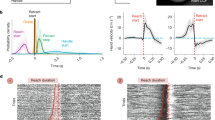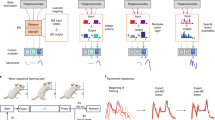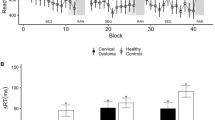Abstract
The graceful, purposeful motion of our body is an engineering feat that remains unparalleled in robotic devices using advanced artificial intelligence. Much of the information required for complex movements is generated by the cerebellum and the basal ganglia in conjunction with the cortex. Cerebellum and basal ganglia have been thought to communicate with each other only through slow, multi-synaptic cortical loops, begging the question as to how they coordinate their outputs in real time. We found that the cerebellum rapidly modulates the activity of the striatum via a disynaptic pathway in mice. Under physiological conditions, this short latency pathway was capable of facilitating optimal motor control by allowing the basal ganglia to incorporate time-sensitive cerebellar information and by guiding the sign of cortico-striatal plasticity. Conversely, under pathological condition, this pathway relayed aberrant cerebellar activity to the basal ganglia to cause dystonia.
This is a preview of subscription content, access via your institution
Access options
Subscribe to this journal
Receive 12 print issues and online access
$209.00 per year
only $17.42 per issue
Buy this article
- Purchase on SpringerLink
- Instant access to full article PDF
Prices may be subject to local taxes which are calculated during checkout








Similar content being viewed by others
References
Doya, K. What are the computations of the cerebellum, the basal ganglia and the cerebral cortex? Neural Netw. 12, 961–974 (1999).
Doya, K. Complementary roles of basal ganglia and cerebellum in learning and motor control. Curr. Opin. Neurobiol. 10, 732–739 (2000).
Ito, M. The Cerebellum and Neural Control (Raven Press, New York, 1984).
Albin, R.L., Young, A.B. & Penney, J.B. The functional anatomy of basal ganglia disorders. Trends Neurosci. 12, 366–375 (1989).
Middleton, F.A. & Strick, P.L. Basal ganglia and cerebellar loops: motor and cognitive circuits. Brain Res. Brain Res. Rev. 31, 236–250 (2000).
Ichinohe, N., Mori, F. & Shoumura, K. A di-synaptic projection from the lateral cerebellar nucleus to the laterodorsal part of the striatum via the central lateral nucleus of the thalamus in the rat. Brain Res. 880, 191–197 (2000).
Hoshi, E., Tremblay, L., Feger, J., Carras, P.L. & Strick, P.L. The cerebellum communicates with the basal ganglia. Nat. Neurosci. 8, 1491–1493 (2005).
Ratcheson, R.A. & Li, C.L. Effect of dentate stimulation on neuronal activity in the caudate nucleus. Exp. Neurol. 25, 268–281 (1969).
Hoshi, E., Tremblay, L., Feger, J., Carras, P.L. & Strick, P.L. The cerebellum communicates with the basal ganglia. Nat. Neurosci. 8, 1491–1493 (2005).
Ichinohe, N., Mori, F. & Shoumura, K. A di-synaptic projection from the lateral cerebellar nucleus to the laterodorsal part of the striatum via the central lateral nucleus of the thalamus in the rat. Brain Res. 880, 191–197 (2000).
Kreitzer, A.C. Physiology and pharmacology of striatal neurons. Annu. Rev. Neurosci. 32, 127–147 (2009).
Gittis, A.H., Nelson, A.B., Thwin, M.T., Palop, J.J. & Kreitzer, A.C. Distinct roles of GABAergic interneurons in the regulation of striatal output pathways. J. Neurosci. 30, 2223–2234 (2010).
Berke, J.D., Okatan, M., Skurski, J. & Eichenbaum, H.B. Oscillatory entrainment of striatal neurons in freely moving rats. Neuron 43, 883–896 (2004).
Schwingenschuh, P. et al. Distinguishing SWEDDs patients with asymmetric resting tremor from Parkinson's disease: a clinical and electrophysiological study. Mov. Disord. 25, 560–569 (2010).
Lacey, C.J., Bolam, J.P. & Magill, P.J. Novel and distinct operational principles of intralaminar thalamic neurons and their striatal projections. J. Neurosci. 27, 4374–4384 (2007).
Ratcheson, R.A. & Li, C.L. Effect of dentate stimulation on neuronal activity in the caudate nucleus. Exp. Neurol. 25, 268–281 (1969).
Llinás, R.R. & Steriade, M. Bursting of thalamic neurons and states of vigilance. J. Neurophysiol. 95, 3297–3308 (2006).
Van der Werf, Y.D., Witter, M.P. & Groenewegen, H.J. The intralaminar and midline nuclei of the thalamus. Anatomical and functional evidence for participation in processes of arousal and awareness. Brain Res. Brain Res. Rev. 39, 107–140 (2002).
Proville, R.D. et al. Cerebellum involvement in cortical sensorimotor circuits for the control of voluntary movements. Nat. Neurosci. 17, 1233–1239 (2014).
Stern, E.A., Kincaid, A.E. & Wilson, C.J. Spontaneous subthreshold membrane potential fluctuations and action potential variability of rat corticostriatal and striatal neurons in vivo. J. Neurophysiol. 77, 1697–1715 (1997).
Koralek, A.C., Jin, X., Long, J.D. II, Costa, R.M. & Carmena, J.M. Corticostriatal plasticity is necessary for learning intentional neuroprosthetic skills. Nature 483, 331–335 (2012).
Houlden, H. et al. THAP1 mutations (DYT6) are an additional cause of early-onset dystonia. Neurology 74, 846–850 (2010).
Calabresi, P., Maj, R., Pisani, A., Mercuri, N.B. & Bernardi, G. Long-term synaptic depression in the striatum: physiological and pharmacological characterization. J. Neurosci. 12, 4224–4233 (1992).
Kreitzer, A.C. & Malenka, R.C. Endocannabinoid-mediated rescue of striatal LTD and motor deficits in Parkinson's disease models. Nature 445, 643–647 (2007).
Gerdeman, G.L., Ronesi, J. & Lovinger, D.M. Postsynaptic endocannabinoid release is critical to long-term depression in the striatum. Nat. Neurosci. 5, 446–451 (2002).
Shen, W., Flajolet, M., Greengard, P. & Surmeier, D.J. Dichotomous dopaminergic control of striatal synaptic plasticity. Science 321, 848–851 (2008).
Calabresi, P., Pisani, A., Mercuri, N.B. & Bernardi, G. Long-term potentiation in the striatum is unmasked by removing the voltage-dependent magnesium block of NMDA receptor channels. Eur. J. Neurosci. 4, 929–935 (1992).
Charpier, S. & Deniau, J.M. In vivo activity-dependent plasticity at cortico-striatal connections: evidence for physiological long-term potentiation. Proc. Natl. Acad. Sci. USA 94, 7036–7040 (1997).
Hilário, M.R., Clouse, E., Yin, H.H. & Costa, R.M. Endocannabinoid signaling is critical for habit formation. Front. Integr. Neurosci. 1, 6 (2007).
de Carvalho Aguiar, P. et al. Mutations in the Na+/K+ ATPase alpha3 gene ATP1A3 are associated with rapid-onset dystonia parkinsonism. Neuron 43, 169–175 (2004).
Calderon, D.P., Fremont, R., Kraenzlin, F. & Khodakhah, K. The neural substrates of rapid-onset Dystonia-Parkinsonism. Nat. Neurosci. 14, 357–365 (2011).
Starr, P.A. et al. Spontaneous pallidal discharge in 15 cases of dystonia: comparison with Parkinson's disease and normal macaque. J. Neurophysiol. 93, 3165–3176 (2005).
Redgrave, P., Prescott, T.J. & Gurney, K. The basal ganglia: a vertebrate solution to the selection problem? Neuroscience 89, 1009–1023 (1999).
Mink, J.W. The basal ganglia: focused selection and inhibition of competing motor programs. Prog. Neurobiol. 50, 381–425 (1996).
Medina, J.F. The multiple roles of Purkinje cells in sensori-motor calibration: to predict, teach and command. Curr. Opin. Neurobiol. 21, 616–622 (2011).
Miall, R.C., Weir, D.J., Wolpert, D.M. & Stein, J.F. Is the cerebellum a Smith predictor? J. Mot. Behav. 25, 203–216 (1993).
Jeljeli, M., Strazielle, C., Caston, J. & Lalonde, R. Effects of centrolateral or medial thalamic lesions on motor coordination and spatial orientation in rats. Neurosci. Res. 38, 155–164 (2000).
Paille, V. et al. GABAergic circuits control spike timing–dependent plasticity. J. Neurosci. 33, 9353–9363 (2013).
Threlfell, S. et al. Striatal dopamine release is triggered by synchronized activity in cholinergic interneurons. Neuron 75, 58–64 (2012).
Nieoullon, A., Cheramy, A. & Glowinski, J. Release of dopamine in both caudate nuclei and both substantia nigrae in response to unilateral stimulation of cerebellar nuclei in the cat. Brain Res. 148, 143–152 (1978).
Nieoullon, A. & Dusticier, N. Changes in dopamine release in caudate nuclei and substantia nigrae after electrical stimulation of the posterior interposate nucleus of cat cerebellum. Neurosci. Lett. 17, 167–172 (1980).
Rossi, S. et al. Cerebellar control of cortico-striatal LTD. Restor. Neurol. Neurosci. 26, 475–480 (2008).
Starr, P.A. et al. Spontaneous pallidal neuronal activity in human dystonia: comparison with Parkinson's disease and normal macaque. J. Neurophysiol. 93, 3165–3176 (2005).
Vitek, J.L. et al. Neuronal activity in the basal ganglia in patients with generalized dystonia and hemiballismus. Ann. Neurol. 46, 22–35 (1999).
Cooper, I.S. Clinical and physiologic implications of thalamic surgery for disorders of sensory communication. II. Intention tremor, dystonia, Wilson's disease and torticollis. J. Neurol. Sci. 2, 520–553 (1965).
Horisawa, S., Taira, T., Goto, S., Ochiai, T. & Nakajima, T. Long-term improvement of musician's dystonia after stereotactic ventro-oral thalamotomy. Ann. Neurol. 74, 648–654 (2013).
Martella, G. et al. Impairment of bidirectional synaptic plasticity in the striatum of a mouse model of DYT1 dystonia: role of endogenous acetylcholine. Brain 132, 2336–2349 (2009).
Bostan, A.C., Dum, R.P. & Strick, P.L. The basal ganglia communicate with the cerebellum. Proc. Natl. Acad. Sci. USA 107, 8452–8456 (2010).
du Hoffmann, J., Kim, J.J. & Nicola, S.M. An inexpensive drivable cannulated microelectrode array for simultaneous unit recording and drug infusion in the same brain nucleus of behaving rats. J. Neurophysiol. 106, 1054–1064 (2011).
Wiltschko, A.B., Gage, G.J. & Berke, J.D. Wavelet filtering before spike detection preserves waveform shape and enhances single-unit discrimination. J. Neurosci. Methods 173, 34–40 (2008).
Acknowledgements
We thank the members of the Khodakhah laboratory for invaluable discussions and comments on the manuscript. This work was supported by grants from the US National Institutes of Health (NS050808, NS079750 and NS071665).
Author information
Authors and Affiliations
Contributions
The studies were initiated by K.K. and C.H.C., who designed the bulk of the experiments. C.H.C. performed all of the experiments except for those shown in Figure 8. R.F. designed and performed the experiments shown in Figure 8. E.E.A.-B. and C.H.C. designed and performed the experiments shown in Figures 6 and 7. All of the authors contributed to writing the manuscript.
Corresponding author
Ethics declarations
Competing interests
The authors declare no competing financial interests.
Integrated supplementary information
Supplementary Figure 1 Striatal recordings and cerebellar stimulation.
(a) Single-unit recordings were made in the dorsolateral striatum by using a drivable 8 wire microarray. The left photograph is a Nissl stained section of the striatum and shows the initial implant site in the dorsal edge of the dorsolateral striatum (DLS). Wires were advanced through the DLS after the initial implant in ≈75 μm increments as needed. The right photograph shows the final location of microwires at the end of the series of experiments done in this mouse. To identify the final location of the recording sites at the end of the experiment, current was passed through each electrode to produce lesions, and the animal was killed and the brain fixed soon after. Red arrows indicate the position of two such lesions. (b) To electrically stimulate the dentate nucleus, a bipolar stimulating electrode was stereotaxically implanted into the contralateral cerebellum during the same surgery when the recording microarray was implanted in the striatum. The stimulating electrode tract is indicated by the red arrows. (c) To stimulate the dentate nucleus optogenetically, ChR2 was expressed in the dentate nucleus by stereotaxic injection of an AAV. A fiber optic implant was stereotaxically placed immediately above the injection site, contralateral to the recording site. The specificity of expression of ChR2 was examined by examination of ChR2-YFP expression (indicated in green; DAPI staining in blue). The location of the fiber optic was also ascertained at the end of each experiment histologically. In the case shown, the fiber optic tract is indicated by red arrows. (d) In separate experiments to confirm that optogenetic stimulation reliably increased firing rate of neurons in the DN, single-unit recordings were made from ChR2-expressing neurons in the DN in awake, head-restrained mice using an optrode. The optrode, made by fixing a fiber optic to a recording electrode, allowed for simultaneous optogenetic stimulation and recording of DN neurons. An example neuron is shown. Stimulus was delivered at time zero.Abbreviations: 4V: 4th ventricle; Int: interpositus nucleus; DN: dentate nucleus; LV: lateral ventricle; DLS: dorsolateral striatum; CC: corpus callosum
Supplementary Figure 2 Striatal response characteristics to cerebellar stimulation.
(a) The average stimulus threshold for producing a response in striatal response with electrical stimulation of the dentate nucleus. (b) The average striatal neuron response magnitudes (for both the excitatory and inhibitory periods) when the dentate nucleus was stimulated at the minimum threshold intensity that produced a detectable response. (c) The fractional change in the response of striatal neurons to electrical stimulation of the dentate nucleus as the stimulus intensity was increased. (d) The average laser power threshold emerging from the fiber optic for producing a detectable response in striatal neurons with optogenetic stimulation of the dentate nucleus. (e) The average striatal neuron response magnitudes (for both the excitatory and inhibitory periods) when the dentate nucleus was optogenetically stimulated at the minimum threshold intensity that produced a detectable response. All data shown are represented as mean ± S.E.M
Supplementary Figure 3 Inactivation of the thalamus
Two approaches were used to inactivate the thalamus, primarily targeting the intralaminar nuclei. (a) Response of a striatal neuron to cerebellar stimulation before, during, and 1 hour post infusion of QX-314 into the thalamus. The infusion cannula was stereotaxically placed to target CL although it is likely that the adjoining intralaminar nuclei might have also been affected. Note partial recovery during the washout period. (b) To test whether specifically inactivating the thalamic neurons would attenuate striatal responses to cerebellar stimulation, the inhibitory light sensitive opsin ArchT was expressed by stereotaxically injecting an AAV targeting the centrolateral nucleus of the thalamus. As can be seen from Arch-GFP expression in green (DAPI staining in blue) Arch was expressed to large extent in the CL and the adjoining regions. The fiber optic was also stereotaxically implanted to target CL, further narrowing the area which was optogenetically manipulated. The fiber optic injury tract is indicated by red arrows and shows that CL was accurately targeted. Abbreviations: LHb, lateral habenula; LDDM, laterodorsal thalamic nucleus, dorsomedial part; HP, hippocampus; CL, centrolateral thalamus; MDL, mediodorsal thalamic nucleus, lateral part; PC, paracentral nucleus of the thalamus; CM, centromedial thalamus; (c) To examine the firing rates elicited by ArchT inactivation, we performed single-unit optrode recordings from thalamic neurons in awake, head-restrained animals (n=7, N=3). Activation of ArchT significantly decreased the firing rate of the thalamic neurons by approximately 80% (****=p<0.0001, one-tailed student’s t-test) for the duration of the 1 second pulse. Data shown in the left panel are normalized to the mean firing rate. S.E.M. is indicated in the dotted-red lines. Mean ± S.E.M. shown in the right panel.
Supplementary Figure 4 Striatal responses to cerebellar stimulations are blocked by isoflurane-induced anesthesia.
Previous work has demonstrated that striatal responses to cerebellar stimulation occur only with strong trains of cerebellar stimulation and at latencies between 50-350 ms. However, the recordings were made under anesthesia. To test whether anesthesia influences striatal responses to cerebellar stimulation, after obtaining reliable striatal responses to cerebellar stimulation in awake mice, the animals were anesthetized using isoflurane. In all cases examined (n=34, N=4) isoflurane-induced anesthesia reversibly abolished cerebellar-induced striatal responses. An example experiment is shown
Supplementary Figure 5 Surgical removal of the motor cortex
To test whether the motor cortex is necessary for the short latency striatal responses to cerebellar stimulation, motor cortices were aspirated bilaterally. (a) Photograph of brain of a mouse after surgical removal of the cortex. For presentation and comparison purposes, the cortex was removed only on one side in this mouse. In actual experiments the motor cortex was similarly aspirated on both hemispheres. (b) Nissl stained coronal slice of brain of an animal actually used for the experiments described in the text. Note the complete removal of the motor cortex. The deformation of ventricles seen here was routinely seen when the cortex was removed. Abbreviations: Cg: cingulate gyrus; M1: primary motor cortex; M2: secondary motor cortex; S1: somatosensory cortex; S2: secondary somatosensory cortex; Str: striatum; cc: corpus callosum.
Supplementary information
Supplementary Text and Figures
Supplementary Figures 1–5 (PDF 789 kb)
Supplementary Methods Checklist
(PDF 418 kb)
Alleviation of cerebellar-induced dystonia by optogenetic inactivation of the thalamic intralaminar nuclei.
ArchT was expressed in the intralaminar nuclei targeting CL, and dystonia was induced by infusion of ouabain into the cerebellum. Inactivation of the thalamus rapidly abated symptoms. (WMV 16057 kb)
Rights and permissions
About this article
Cite this article
Chen, C., Fremont, R., Arteaga-Bracho, E. et al. Short latency cerebellar modulation of the basal ganglia. Nat Neurosci 17, 1767–1775 (2014). https://doi.org/10.1038/nn.3868
Received:
Accepted:
Published:
Issue Date:
DOI: https://doi.org/10.1038/nn.3868



